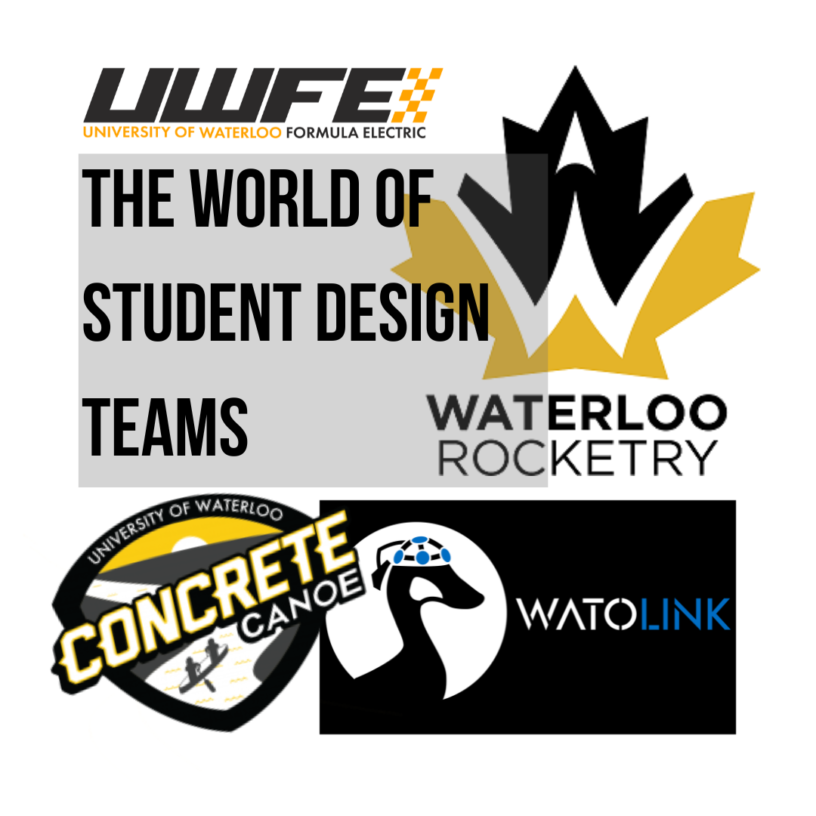The University of Waterloo is home to so many spectacular student design teams. We talked to a few so that you can get to know them and consider joining the team with an objective most aligned with your interests!
WATOLINK performs research and development of new technology related to brain computer interfaces, allowing students to gain experience in neuroscience and neuroimaging techniques early in their careers. In 2022, they achieved 1st place in the global NeuroTechX Competition. Mainly composed of BME and SYDE students, the team is split off into smaller sub-teams consisting of operation leads, project leads, and core members. The operation leads manage resources for the team and assures the team has adequate funding. Whether the project consists of brain controlled video games or wheelchairs, project leads are the first point of contact and are responsible for their development. The majority of the software, hardware and firmware development for the brain-computer applications to work are completed by core members. It is an excellent opportunity for students to learn what it takes to design and integrate different components of a brain-computer interface (BCI) system. Co-founder Avery Chiu (4B Mechatronics) says his “favourite part is seeing the expression on people’s faces when they are able to control interfaces such as robots with their mind seamlessly,” in relation to his experience at WATOLINK.
Waterloo Rocketry takes students from engineering, math, science, environment, arts, and health. The team focuses on teaching students so that they have the knowledge they require to become capable rocket engineers, and can have an environment to gain experience applying engineering skills that many have learned in their courses. As a member of the team, you have the opportunity to participate in engine tests, electronic tests, constructing rockets as a team, and eventually, seeing the rocket launch in the forests around Timmins, Ontario. The team has 2 team leads and 10 sub-teams such as the airframe and propulsion teams, which build the rocket body and make the engine/fluid systems/custom valves respectively. Other teams include business, controls, electrical, flight dynamics, infrastructure, payload, recovery, and software. Team lead Tessa Pugh (‘27 Mechanical) says, “The people I get to work with every day make this team incredible. I love seeing them grow and learn, I love the late night problem solving, I love seeing people take on responsibilities just outside what they’re capable of and succeed.” Controls sub-team lead, Joe Dolina (‘26 Mechatronics) agreed, saying their favourite part was, “The community. The best memories of my years here at UW are with my friends on the rocketry team, and I wouldn’t enjoy my 5 year slog through eng nearly as much without them”.
Waterloo Formula Electric participates in competitions with static and dynamic events. They design and manufacture Formula 1 style electric vehicles from scratch every year. Each year, they aim to improve the reliability and performance of their vehicles. Always bringing pride to their design team, Formula Electric was able to place 5th last year despite a last minute motor failure. This year, the team has at least 4 upcoming competitions in New Hampshire, Michigan, Pittsburgh, and Toronto. On the team, members have the opportunity to gain experience using software and programming languages such as Ansys, StarCCM, FreeRTOS, ALtium, LTSpice, Solidworks, C, and Python. Some sub-teams include aerodynamics, accumulator and powertrain, business, chassis, electrical, firmware, and suspension. These teams provide opportunities for members to design 600V batteries, pedals, brakes, PCB’s, and much more. Formula Electric is an amazing environment to gain industry experience. Tesla, Lucid, Apple, Neuralink, and other large companies have sought out Formula SAE students for their excellent design experience. Technical lead Owen Brake (4B Mechatronics) has had the opportunity to develop his understanding of vehicle dynamics and electrical knowledge. He designed this year’s high voltage battery and is currently designing a high voltage motor controller. Owen states, “These broad experiences are frankly once in a lifetime.” and project manager Jeremey Racine (‘26 Mechanical) adds, “It’s not everyday that you get to design, build and drive the same car, much less 5 different times throughout your university degree”.
Industry 4.0 has a mission to create solutions in technology, systems design, human capital, and process engineering. The team also supports students in their career and personal development through its vibrant and caring community. Mainly consisting of management engineering students, members participate in co-op panels, resume critiques, high school case competitions, and executive team-building events. There are many roles available to members including team director, software developer, marketing lead, program manager, external coordinator, research and development & operations lead, and more. Sponsorship coordinator Demir Eren (1B Management) says the amazing sense of community, “makes me feel like I am always part of the family. It’s an environment where I always feel like I can bring new ideas to the table, and comfortably speak to the people in charge without that sense of hesitation.”
Concrete Canoe is an inclusive, fun, and unique environment for students to develop engineering design along with technical and soft skills. The team leads are all very welcoming and will teach you everything you need to know. The hull design sub-team generates and designs the canoe through modelling and CFD analysis. They produce shear force and bending moment diagrams. The concrete mix team optimizes the concrete mix to be lightweight with high tensile strength and reduced environmental impacts. The sustainability team works closely with all other sub-teams to reduce environmental impacts and keep finances sustainable. The construction team creates foam molds, casts the canoe, manages curing conditions, and finishes the cured canoe. The reinforcement design is completed by the structural team, while the budget and expenditures, sources funding, and sponsorships are the finance sub-team’s focus. The aesthetic, team merchandise, and technical display are designed by the spirit team. The programming team performs calculations in Python and runs the structural analysis of the canoe. Meanwhile, the paddling team trains for races at nearby conservation areas. Competing in the Canadian National Concrete Canoe Competition (CNCCC), the team’s objective is to innovate lightweight, low-waste, sustainable concrete canoes with construction strategies applicable to the wider construction industry. Last year, the team competed in London and placed 5th overall despite an unfortunate combination of a displaced knee and cold joint, which led to a punctured hull mid-race, resulting in a “floating bathtub”. Team Captain Kat Linscott (4B Environmental) says her favorite part about the team is, “The team atmosphere! Everyone is always really nice and they’re happy to teach you and get you involved in projects.”
UW Biomechatronics develops medical devices and solutions for patients that they connect with through E-nable and recently Tetra; Tetra allows students to work with real patients using a diverse set of medical device needs and develop solutions unique to them. This term, the E-nable team is working on finding a patient a custom print prosthetic. EMG Fabric is perfecting their machine learning algorithms and developing reusable textile electrodes. Spine Biosticklers is developing a posture recognition software to be used for patients who have undergone major spinal surgery to aid in their rehabilitation if it detects dangerous postures post surgery. Transitioning into the lead role of Biomechatronics, Anna Polack (3A Biomedical) says her favorite part of being apart of UW Biomechatronics, “is seeing this multidisciplinary team come together to make strides in the research and development field.”





Leave a Reply